Sansevieria or vernacular “mother-in-law tongue”, “pike tail” does not need special care at home, but it is one of the main sources of oxygen. Transplanting and propagating sansevieria is very simple and even beginner growers can do this. This indoor plant is perennial with long leaves that grow from the root up. The sheet length can reach up to 1 meter. There are approximately 10 types of sansevieria, they are popular both at home and in offices, due to their unpretentiousness.
Content
Lighting
For sansevieria it does not matter what the lighting will be. It will grow both on the sunny side and in the shade. The only thing is that variegated species may lose their color a little if there is a shady place. In the summer, the plant should be taken out to the balcony or the veranda, but pay attention to the fact that rain should not get on the indoor flower.
Temperature
Sansevieria is absolutely indifferent to temperature changes. In summer, she feels great at temperatures from 18 to 25 ° C, and in winter from 14 to 16 ° C, but not lower than 10 °. From a lower temperature, growth can slow down or completely stop.
 You may be interested in:
You may be interested in:Watering and humidity
When leaving at home for sansevieria, it is worth remembering that the plant can not be transfused. That is, watering should be moderate and only after the earthen coma has dried. In the summer, once every seven days is enough, and in the winter it is approximately once a month, but we must not forget that if the plant is next to the battery, then watering is done as the soil dries.
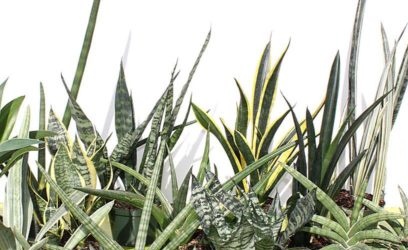
This houseplant normally tolerates dry air in apartments, and the dust that forms on the leaves can be wiped with warm water.
Top dressing
It is enough to feed Sansevieria with liquid fertilizer for cacti in the spring-summer period 1 time per month. For top dressing, dilute fertilizer in water in a ratio of 2: 1, and for varieties with pronounced stripes 3: 1, otherwise, due to an excess of dressing, “mother-in-law's tongue” may lose its color.

Sansevieria transplant
Often transplant Sansevieria is not enough, once every two to three years. For this, plants are suitable for low, but wide and deep pots, as the roots grow in width. Transplantation is recommended when the roots begin to emerge from the soil.
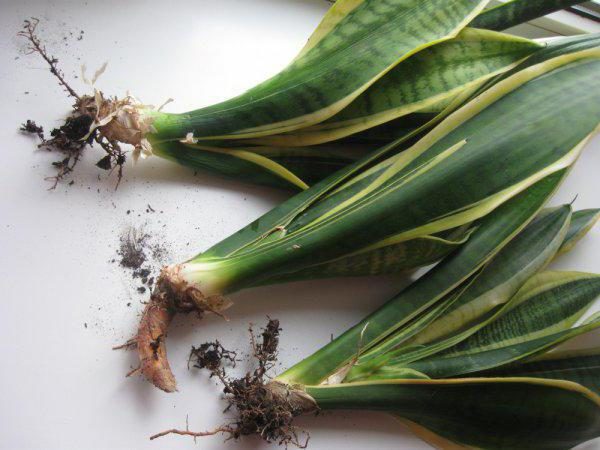
Reproduction of Sansevieria
How to propagate sansevieria at home? This plant propagates quite easily:
- leafy cuttings.
If you wait a long time before the transplant, then this option is suitable. Small pieces are cut from an old leaf of a houseplant, approximately 5-7 cm perpendicular to the veins.For this method, it is worth taking exactly that sheet of the outlet that will no longer release new leaves.
The cuttings obtained by this method are not immediately planted, they are given time to dry out a little, and then they should be buried in moist sand by a third of the cuttings and cover the plant with a film or a glass jar. Watering occurs through the pan. Rooting of cuttings occurs after 6-8 weeks. The temperature regime should be kept from 21 to 25 ° С.
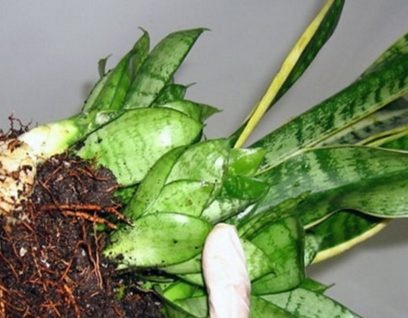
- division of the root.
This method is preferred when transplanting sansevieria. For this, an adult plant must be carefully removed from the pot. Clear the roots of the earth by blurring. Using a knife, you need to separate the lateral offspring. To cut the root system of sansevieria, leaving 7-10 cm.
In order for moisture to evaporate less, the leaves of the cuttings are shortened to 30 cm. The places of the slices should be sprinkled with crushed charcoal and dried for several hours in a shady, ventilated place. Plant separated seedlings in separate containers. Parts of the roots should be planted to the same depth in which they were before the transplant. Watering is done after a day.
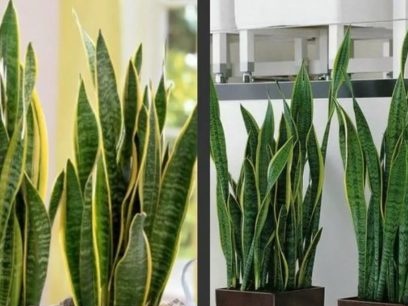
- side shoots. In the case of this method of propagation, the lateral shoots are carefully separated with the root and planted in a separate container.
Types and varieties of sansevieria
Despite the different types of sansevieria, one of the most unpretentious and decorative indoor flowers. They are most often used by designers to create compositions of flowers or decorating the interior.
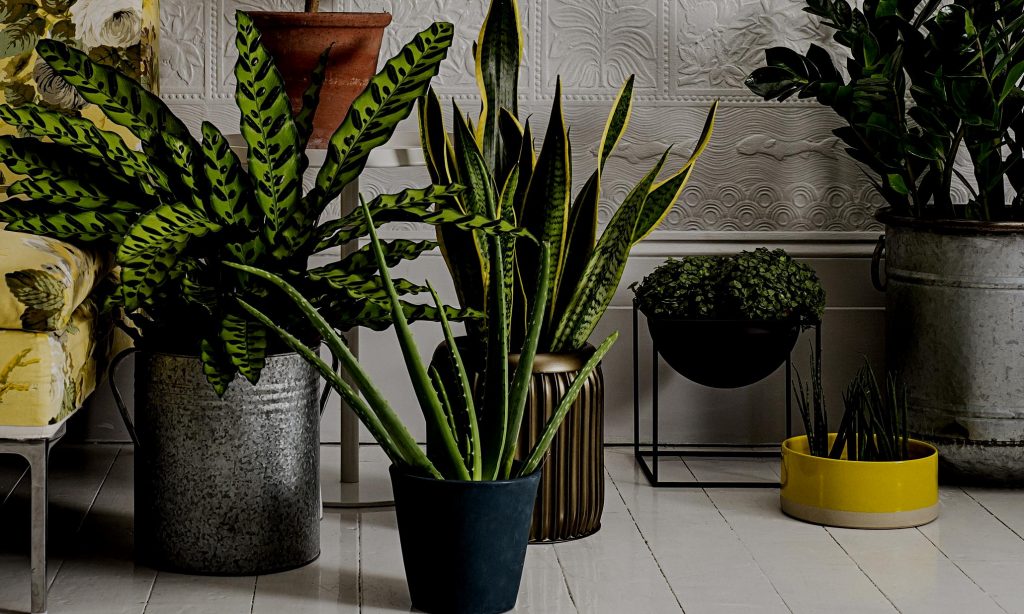 You may be interested in:
You may be interested in:Hanni
This undersized and rather beautiful houseplant was bred in 1941 from Sansevieria Laurenti, a famous breeder S. Khan. Hence the name. This rosette variety is not higher than 30 cm in height.
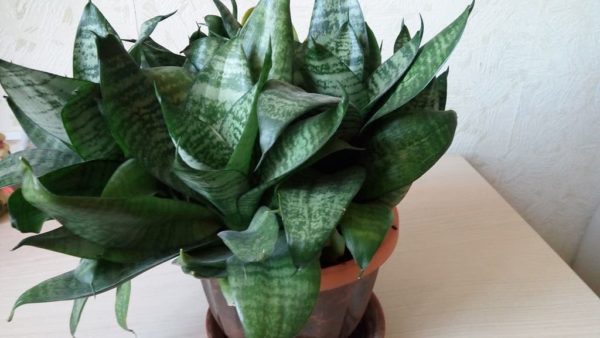
In 1953, Khan received another variety with yellow stripes on the sides of the leaves - Golden Hanni. Unlike other types of “pike tail” this variety likes bright lighting, but note that in very sunny weather the plant must be applied. And in shady places, especially in winter, you need to do some backlighting. With the right light, the color appears brighter.
In summer, the temperature regime varies from 20 to 25 ° C, in spring and autumn from 18 to 20, and in winter and a rest period of 15 ° C, the optimum temperature.
Three-way Sansevieria
Sansevieria of this species is the most common, and the height of this plant at home is from a meter to 150 cm.
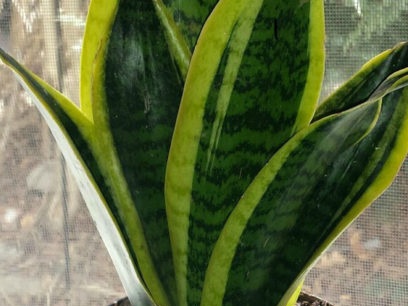
This view needs to be placed on bright windows, with the exception of the north. The leaves of the “mother-in-law's tongue” are painted in a deep green color, and pale yellow shades along the edges. The leaf itself is covered with an unusual pattern, which gives beauty to the leaves.
Flowering occurs in spring or autumn: the flowers are small, very fragrant, light green in color. For planting and cultivation, geranium soil is quite suitable.
Cylindrical sansevieria
The variety of this sansevieria is unlike other species with its elongated leaves. The name comes from the shape of the leaves: they are rounded along the entire length, so they resemble a cylinder.
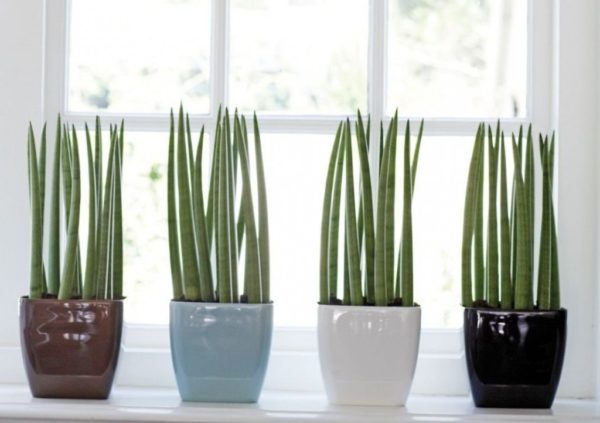
This species was bred by breeders, so they cannot be seen in the natural environment. At home, if you properly care for the plant, it can reach a height of 130 to 150 cm.
The flowers of the Cylindrical Sansevieria are also not similar to the other relatives. They range from white to pink, appearing on a meter-tall flower stalk.
Laurenti
This is the main variety of sansevieria, from which many new species have been bred by breeders. Laurenti leaves grow upwards, and a yellow stripe can pass along the edge of the leaf.
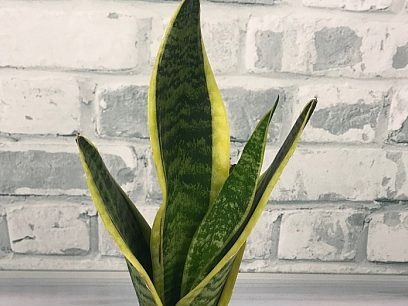
Zeylanika
The most popular type of pike tail, which is in great demand along with three-lane sansevieria. But this variety has its own distinctive features: Zeilanica leaves are wide and covered with small specks that have a silver tint when an indoor plant reaches adulthood. They also have a traditional pattern, but there is no white or yellow strip along the edge, they are located along the entire length of the central part.
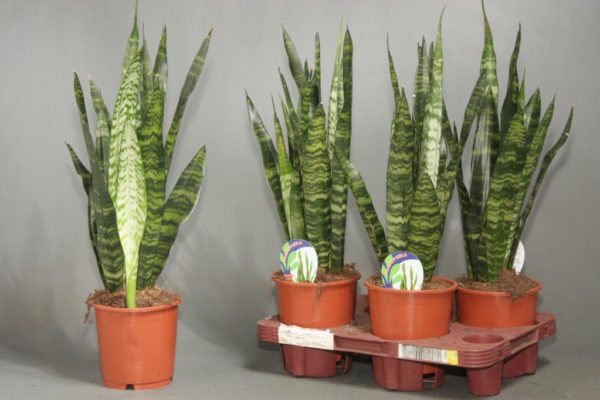
White Sansevieria
Senseicion Bantel or White Sansevieria - this species was bred in 1948 by breeder Gustav Bantel. This variety differs from others in its unusual coloring: leaves have white longitudinal stripes, alternating with dark green.
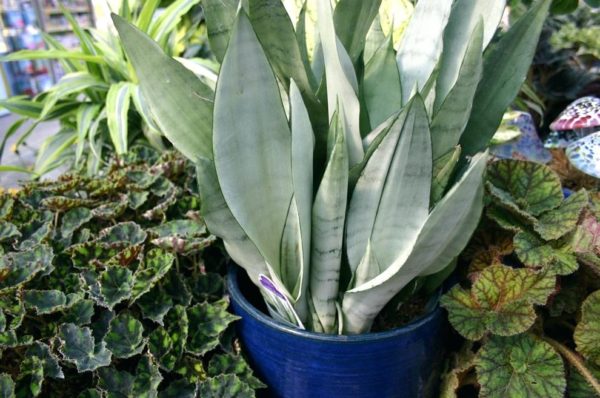
Due to the fact that white sansevieria grows rather slowly, therefore it is one of the rare species.
- Sansevieria Kirki;
- Sansevieria Pingvikula (“walking”);
- Sansevieria Staki;
- sansevieria francisi;
- Sansevieria Ehrenberg;
- Twisted Sister;
- Sansevieria Eilenzis;
- Silver Queen.
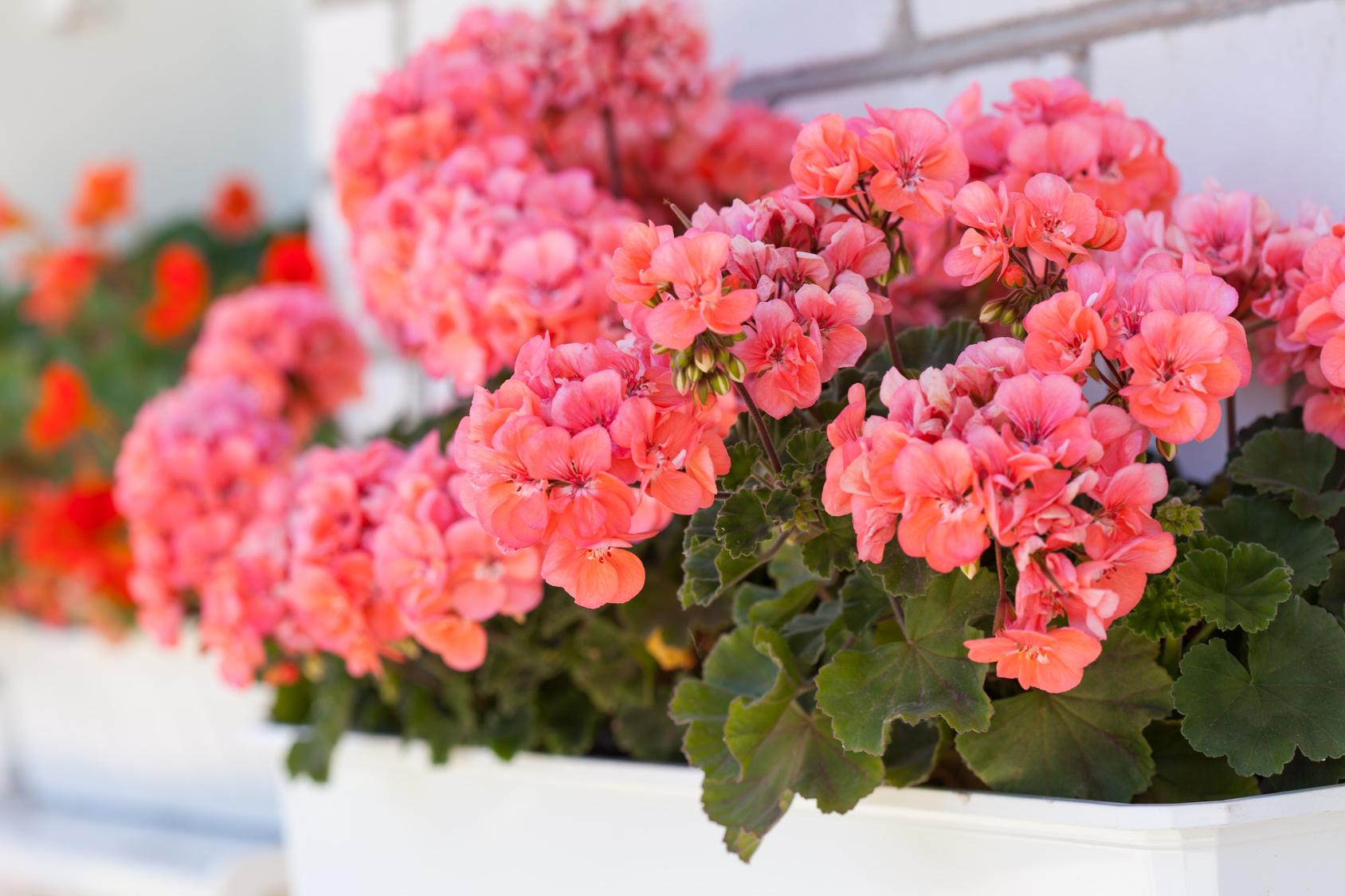 You may be interested in:
You may be interested in:Diseases and Pests
The main diseases and pests of the pike tail are:
- spider mite. The leaves of the plant become pale yellow, solid spots appear on a white hue, and the leaf itself dies off - this all indicates that this pest appeared on a room flower. The cause of the appearance may be in dry air. To prevent the disease, sansevieria leaves periodically wipe with a damp cloth. Actellik is well suited for treatment;
- Anthracnose - this disease gives itself away by the fact that brown spots appear on the surface of the leaves, gradually increasing in size. Over time, the leaf dries. Violation of watering, or rather, abundance of moisture, often leads to this disease. For treatment, treatment with Fungicide solution is recommended.
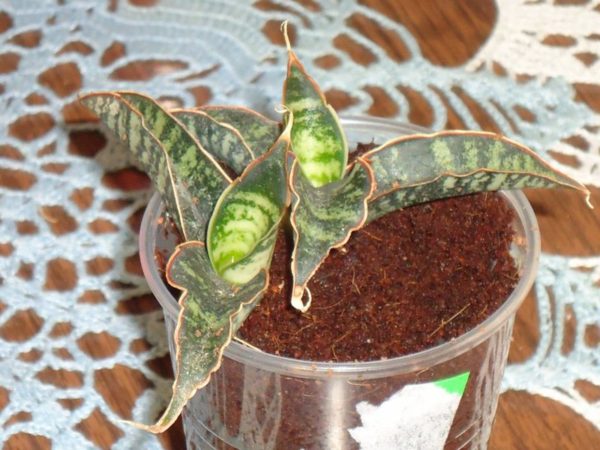
- Tryps - this pest on the inner side of the leaf lays a large number of eggs. The upper side is dotted with white dots, then a grayish-brown shade with a silver sheen appears. For treatment, chemical preparations are used.
- Mealybug - in this pest, reproduction occurs at the base of the leaves of the rosette, where it sucks the juice from a houseplant. As a result of this, leaves are bent, and as a result they turn yellow and die. For treatment, it is necessary to remove all pests, and wipe the sheets with a sponge dipped in warm water. If the plant is severely affected, then it should be treated with Karbofos.
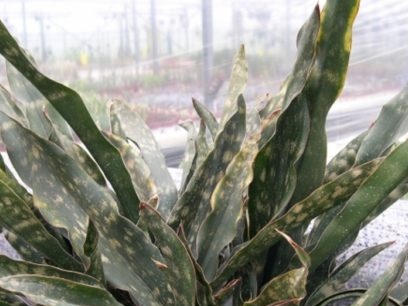
- With excessive moisture, the leaf turns yellow and becomes soft at the base. In order to prevent further decay, it is recommended to transplant into another pot, remove damaged leaves. But, if the root system went down, then the plant is almost impossible to save.
- At temperatures below 15 ° C and dry earthen coma, the leaves of sansevieria become lethargic and rot. Salvation will be only a change in temperature and the removal of all damaged areas. If the rot of the stem has gone, then the upper sections of the leaves that are not damaged can be rooted.
Possible problems when growing at home
In conditions of home care for sansevieria, these problems can be present:
- direct sunlight has a devastating effect on sansevieria, from loss of color brightness to sunburn.
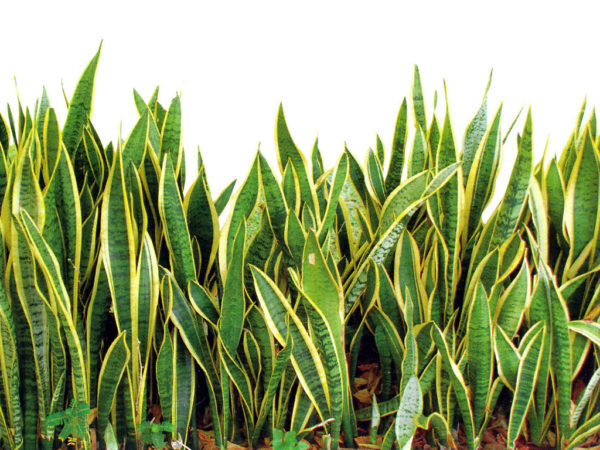
- When feeding plants with fertilizer for cacti, it is necessary to observe the proportions, i.e. dilute twice as much with water than is written in 2: 1 instructions. If you do not follow this, then from an overabundance of fertilizer, the pike tail will begin to rot.
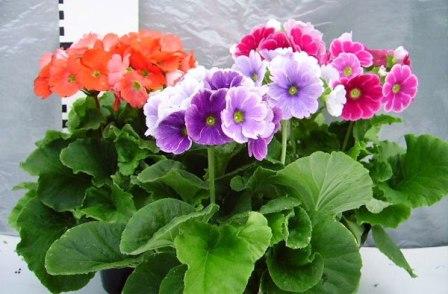 You may be interested in:
You may be interested in:- With improper soil composition, sansevieria will slowly grow, and may, in general, stop growing. The recommended composition based on sod with the addition of sheet soil and sand, in the proportions of 4: 2: 1.
- Problems with excess moisture. Avoid frequent watering. In the spring-summer period, watering is carried out no more than 1 time per week, and in winter time it is reduced to 1 time per month.
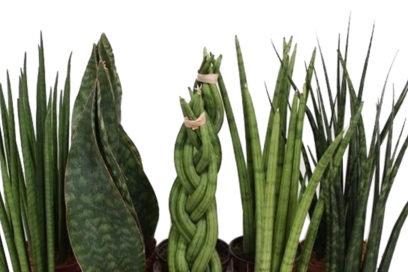
If you properly care for your sansevieria, it will delight you not only with its fragrant flowers, but also saturate your home with oxygen.




 10 beautiful annuals that bloom all summer
10 beautiful annuals that bloom all summer Sow in the ground, without seedlings: 10 beautiful and unpretentious flowers
Sow in the ground, without seedlings: 10 beautiful and unpretentious flowers Platicodon planting and outdoor care
Platicodon planting and outdoor care Hosta - planting and care in the open ground in the Urals
Hosta - planting and care in the open ground in the Urals